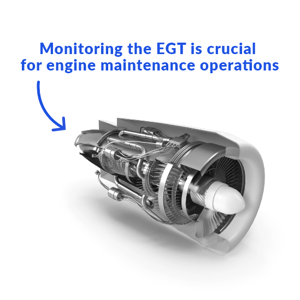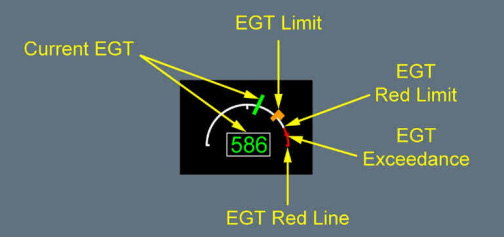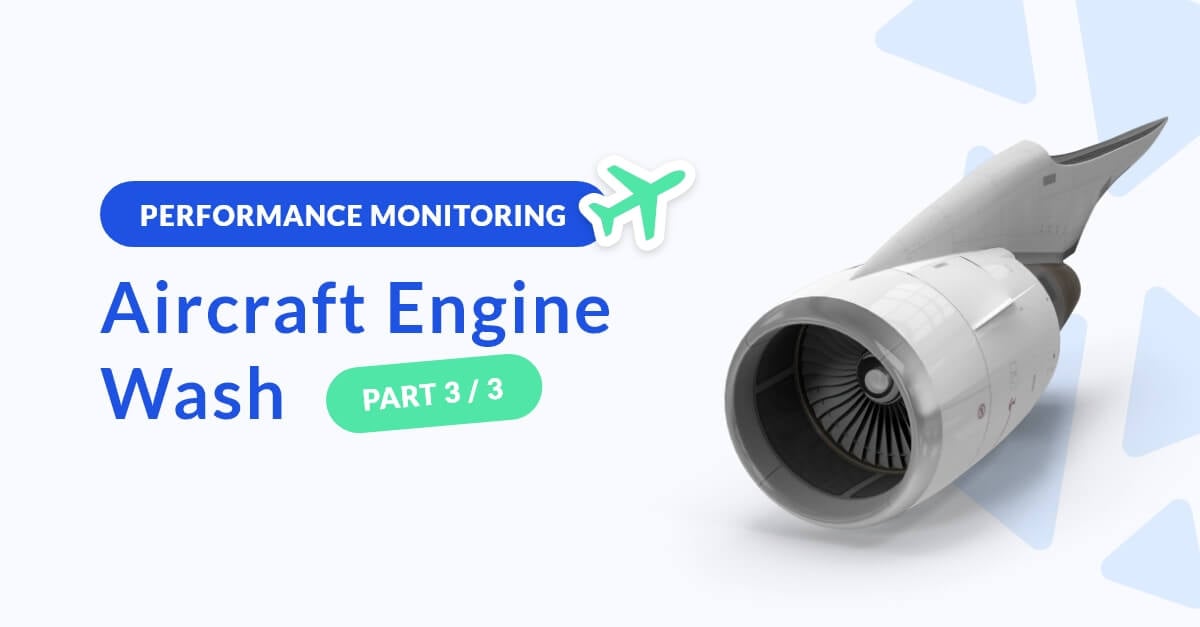Impact of Engine Wash on Exhaust Gas Temperature (EGT)
Have you ever wondered how aircraft engines are washed and why it is important to do so? If yes, then this series of articles is made for you. We will address the basics of engine wash, why it is essential to monitor it with adapted tools, and how it impacts the Exhaust Gas Temperature (EGT).
Learn more about engine wash in this three-part series:
- Part 1: Aircraft Engine Wash 101: Why, what, how, when, and how often?
- Part 2: How to optimize your aircraft engine wash schedule using data?
- Part 3: The impact of the engine wash on Exhaust Gas Temperature (EGT).
In this third and last installment, we explore the positive impact of engine wash on the Exhaust Gas Temperature (EGT). We will see how this maintenance action improves both the EGT margin and fuel efficiency.
What is the Exhaust Gas Temperature?
The Exhaust Gas Temperature refers to the temperature of the hot gases produced by the engine at the exit of the exhaust nozzle. It is measured by temperature sensors placed at the Low-Pressure Turbine (LPT) of the engine. Usually expressed in degree Celsius (°C), it is an essential parameter for engine health monitoring, performance assessment, and efficiency.

The EGT fluctuates between 600°C and 1000°C for typical jet engines during normal operations. Temperature readings are transmitted to the cockpit for the flight crew to monitor and are also part of the recorded parameters.
Monitoring the EGT is crucial for engine maintenance operations: finding EGT values that are much higher or lower than normal can indicate issues such as compressor or turbine damage, fuel system problems, or combustion issues. It is also an important parameter to consider for assessing the engine's fuel efficiency: slightly higher EGT values can indicate a higher fuel consumption, while lower readings can indicate improved fuel efficiency.
What is the Exhaust Gas Temperature limit?
For each engine type, manufacturers specify a maximum exhaust gas temperature, known as the EGT limit or EGT red limit. This threshold shouldn’t be exceeded for a certain amount of time to ensure safe engine operations and prevent damage.
The value can be found in the FCOM (Flight Crew Operating Manual) or the AFM (Aircraft Flight Manual), indicated by a red line on the EGT gauge in the cockpit. In flight, the crew consistently monitors EGT readings to ensure they do not exceed the limit, especially in demanding operational conditions like takeoff at TOGA (Takeoff/Go Around) thrust level in warm weather conditions. Exceeding the EGT limit can result in engine damage or failure and compromise safety.

Example of A330 EGT indicator with EGT red limit
What is the Exhaust Gas Temperature margin?
The Exhaust Gas Temperature margin is the difference between the engine's EGT during a full-rated takeoff at reference conditions and the EGT limit set by the manufacturer. This margin represents the safety cushion between an engine's actual exhaust gas temperature and the maximum safe operating temperature.
By monitoring the EGT margin, maintenance teams can determine whether the engine is performing efficiently and within safe limits. When necessary, they can take appropriate maintenance actions on engine parts and perform engine wash to increase the EGT margin and improve fuel efficiency.
How does engine wash increase the EGT margin?
Different factors, such as engine deposits, fouling, and parts degradation, can cause a reduction in the EGT margin. As seen in Article 1 - Aircraft Engine Wash 101: Why, what, how, when, and how often?, residue on the engine parts affects their efficiency, namely by restricting the airflow, which leads to an increase in EGT. By removing these deposits through engine washing, the airflow through the engine is restored, which can improve the engine's efficiency and reduce the EGT.
EGT margin improvements can translate into several benefits, such as increased engine performance, reduced fuel consumption, or increased engine lifespan. The extent to which engine washing improves the EGT margin depends on the engine type, the condition of the engine, and the method used for washing. But based on our customers’ experience, EGT margins are improved after an engine wash, with usual margin improvements ranging from 3°C to 7°C.
How to monitor EGT margin improvement?
Airlines must scrupulously monitor the EGT margin to prevent exhaust gas temperature from exceeding the red limit. Usually, this margin needs to be assessed during TOGA conditions but this is not always possible. The engine's maximum thrust during takeoff is occasionally safeguarded under certain specific Outside Air Temperature (OAT) conditions, potentially introducing bias to the measured EGT margin. As a result, methodologies are in place to recalculate the accurate margin.
As introduced in Article 2 - How to optimize your aircraft engine wash schedule using data?, gaining access to your engines' data will allow you to oversee their performances. Analyzing the trend of engine parameters, such as EGT, EGT margin, or fuel consumption, both prior to and following engine cleaning, will provide insight into the effectiveness of the washing process. This monitoring can be done through various systems and methods, such as ACMS reports or flight data analysis. Ground aircraft performance monitoring systems such as SkyBreathe APM can give you the daily EGT margin for each of your tails and even automatically alert you when the margins go under a certain threshold.

Panel dedicated to the EGT margin in SkyBreathe APM
Monitoring the improvements in EGT margin after engine washing can ensure that your engines are performing optimally and help airlines evaluate the effectiveness of their maintenance program.
This last article closes the series of articles on the benefits of the engine wash on aircraft engines. You now have all the cards in hand to understand why airlines should plan regular engine washes to enhance safety and have more efficient, cost-effective, and sustainable flight operations!
LEARN MORE
[CASE STUDY] See how Smartwings uses intelligent data to improve aircraft performance.
>> Download the free case study



.jpg?width=400&height=209&name=case-study-smartwings-airline-aircraft-performance-monitoring-header%20(1).jpg)